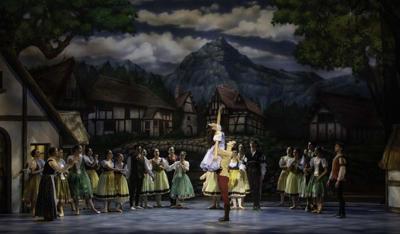
At center, Journy Wilkes-Davis as Albrecht and Nanako Yamamoto as Giselle.
“Giselle” reigns as the supreme exemplar of Romantic era ballets, those 19th-century narrative works depicting some poor chap’s pursuit of an ideal, unattainable female creature whose mesmerizing ethereality situates her somewhere beyond our terrestrial human existence.
Not just in ballet, but across musical, literary, and visual arts, Romantics prized the emotional and spiritual realms over the real and the rational. Yet while they proffered convincing drama and displayed solid ballet technique, in their affecting, new production of “Giselle,” presented last weekend at the New Brunswick Performing Arts Center, New Jersey’s American Repertory Ballet came up short in conjuring Romanticism.
The beloved ballet tells the tale of a young peasant woman, Giselle, who falls in love with Albrecht, a nobleman masquerading as a commoner. When he breaks her heart, she goes mad and dies. But in the end her enduring love saves Albrecht from the wilis — the ghostly spirits of jilted females who seek revenge by forcing men to dance until they die.
Choreographed by Jean Coralli and Jules Perrot, to achingly beautiful music by Adolphe Adam, “Giselle” premiered in Paris in 1841. ARB’s production, danced to an exciting recording of Adam’s score, features the traditional Coralli-Perrot choreography, here staged by company ballet master Ian Hussey, along with Aydmara Cabrera, Jose Manuel Carreno, and Ana Novoa — three Cubans with notable links to “Giselle’s” history.
Director of ARB’s affiliated Princeton Ballet School, Cabrera was a principal dancer with the National Ballet of Cuba under the direction of former ballerina Alicia Alonso, who is considered among the greatest Giselles of the 20th century. Novoa also danced with the National Ballet of Cuba, where she performed the role of Giselle. And ballet superstar Carreno (often partnered with Novoa) performed the role of Albrecht with both the English National Ballet and American Ballet Theatre.
In coaching ARB’s dancers, this artistic team appears to have emphasized the emotional aspects of the ballet. At the matinee performance I attended on February 15, I was struck by how well-acted it was.
Too often in story ballets, one sees phenomenal displays of physical prowess from young dancers who mar their performances with unbearably phony acting. But not here. From the moment Journy Wilkes-Davis steps onstage in the role of the disguised Albrecht, you can tell the character’s a weasel. As Hilarion, a peasant gamekeeper enamored of Giselle, Daniel Cooke manages to elicit genuine sympathy. And top acting honors go to Emily Parker, who, in the thankless role of Bathilde, Albrecht’s intended, finds the right combination of elegance, warmth, and superiority to express the nuanced character of a patronizingly generous person of privilege.
Only Nanako Yamamoto, as Giselle, disappoints in the acting department, though she shows complete command of the role’s technical requirements. Unlike the principal role in the classical-period ballet “Swan Lake” — which in large part measures technique — “Giselle” presents a wider-ranging test of a ballerina’s expressive capabilities. She must first exude vulnerability as the innocent young peasant, go furiously insane in a wildly dramatic mad scene, then communicate a chilling other-worldliness as a wili ethereally performing fiendishly difficult footwork.
Effectively hysterical in her mad scene, Yamamoto dances throughout with a strong, streamlined precision that underlines the classical beauty of her movements. Yet rather than alter her physicality, she conveys her youth through pouty, wide-eyed facial expressions that look babyish and feel dated. We’ve moved past the notion that young women should ever act like children.
Yet more importantly, when Giselle returns as a wili in the second act, Yamamoto’s movements don’t soften or lighten enough to embody that ethereal Romantic aesthetic. Nor do anyone else’s. The corps of wilis — though highly impressive in their unison ensemble work — lacks ghostliness. Costumed by Christina Giannini in the signature long white tutus of the Romantic Age, they create stunning visual images, yet feel more like a pretty precision dance troupe than an unearthly cohort of revengeful feminine spirits.
ARB’s “Giselle” is moving and, at times, thrillingly danced, but it’s not as eerily transporting as this Romantic masterpiece should be.
Giselle will be presented again, in partnership with the Princeton Symphony Orchestra at the McCarter Theatre Center on Saturday, May 2, at 2 p.m. www.arballet.org


